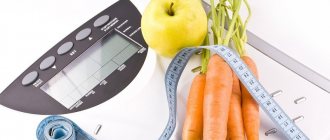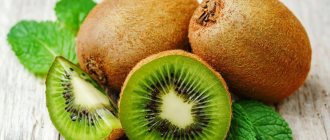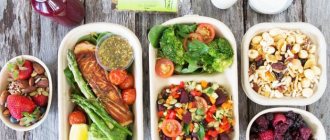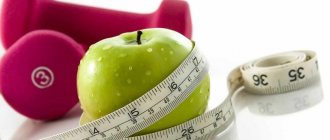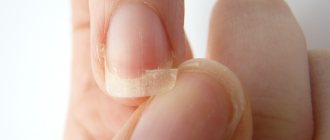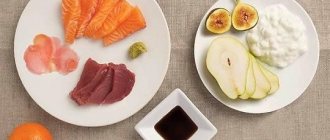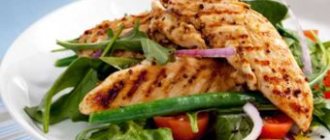The 1000 calorie diet is one of the most effective methods of combating excess weight. She has a varied diet and quick results: up to minus 12 extra pounds in 4 weeks! Get a diet menu and lose weight!
- Reviews from those who have lost weight
Author: Kristina Lobanovskaya, doctor, practicing nutritionist Article updated: 11/10/2020
Among the most effective methods of combating excess weight, many experts highlight nutrition with calorie counting. When used correctly, this approach is guaranteed to achieve the desired result, since it takes into account the individual daily caloric intake, determined taking into account the age, gender, activity level, usual diet and body parameters of a particular person. To lose weight, it is recommended to consume 70–80% of the established calorie requirement, which creates a calorie deficit and forces the body to use its own fat reserves to replenish energy. Based on this principle, a universal weight loss method was created - the “1000 calorie” diet.
Fractional meal plan for a balanced diet of 1000 calories per day
The energy value of foods, that is, their calorie content, is measured in calories. This refers to the amount of energy the body receives from food when it is fully absorbed.
There is a basic daily minimum amount of calories that a person should consume to ensure normal mental and physical activity. Each person's energy needs are different and depend on age, gender, lifestyle, and physiological characteristics.
Often, we receive much more calories from food than our body requires, and this entails a set of extra pounds. Limiting the number of calories you consume is the basis of any weight loss diet.
Recently, the 1000 calorie express diet has become especially popular, the main requirements of which are:
- the total number of calories of the entire daily diet should not be more than 1000 calories
- eat plant foods daily (vegetables, herbs, fruits)
- mandatory inclusion of protein foods of animal origin
- nutrition during the diet is quite balanced and includes fats, carbohydrates, proteins, mineral and vitamin components
It is very important to take into account not only the volume and calorie content of food consumed, but also how it is consumed. Our usual three meals a day is not the best option for this diet, because:
- The longer the intervals between meals, the lower the level of glucose in the blood, and the higher the level of cortisol (stress hormone). And it, in turn, changes metabolic processes in the body.
- With three meals a day, our body has time to absorb all the energy from the food received, and a new portion is not expected soon. This leads to the fact that the body begins to store substances “in reserve” in the form of fat deposits.
- The stronger our hunger, the stronger our desire to eat large amounts of food.
With fractional feeding, food is delivered at equal, short intervals. Therefore, fat is not stored “for a rainy day.” In addition, small portions are digested faster, which promotes full absorption of nutrients.
Divide your calories correctly
Fractional meals on a 1000 calorie diet involve the following meals:
- breakfast first - “slow carbohydrates” (cereals, cereals, bread) and low-fat proteins (cottage cheese, eggs). These products are digested for a long time, providing a supply of energy for the whole day. Therefore, you will not feel hungry for a long time.
- second breakfast (lunch) – fruit or juice, nuts.
- lunch - soups (vegetable, in weak fish or chicken broth), stewed vegetables, lean meat.
- afternoon snack - nuts, fruits, dairy products.
- dinner - vegetables, a small piece of fish, meat, seafood is allowed.
- evening snack - fermented milk products (if you have a strong desire for something sweet - dried fruits or a spoonful of honey).
The recommended calorie distribution for this diet is as follows:
- breakfast with lunch – 300 kcal each
- intermediate meals – 50-100 kcal
- dinner - 200-250 kcal
Basic rules for this type of diet:
- intermediate meals should be 2 times less than the main meals.
- It is better to make breakfast the most energetically nutritious meal.
- break between meals – not exceeding 3.5 hours.
- The last snack is no later than 1.5 hours before bedtime.
- Dinner should not be the main meal of the day.
- The daily water requirement is at least 1.5-2 liters.
- drink water no later than 30 minutes before meals and no earlier than an hour after it.
- You need to eat strictly according to the schedule.
- If one meal is missed, you cannot add this portion to the next meal.
- eat slowly, chewing your food thoroughly - then the food is better absorbed, and the brain quickly receives a signal of satiety.
- There is no need to count calories in the tea or coffee you drink; the amount of milk and sugar added to the drinks is calculated.
- Avoid excessive physical activity, give preference to yoga or Pilates.
- use small-sized dishes - the reduction in portions will not be noticeable.
- Buy a digital kitchen scale to weigh a portion of food and calculate how many calories it contains.
Calorie calculation
We draw your attention to the fact that the amount of 1000 calories is much less than what the average adult needs during the day.
Therefore, you can switch to a diet with a consumption of less than 1200 calories only after consulting a doctor.
Quitting the diet
Since losing weight on the 1000 calorie diet is quite extreme, it is necessary to exit the process correctly in order to maintain your results. To do this, you need to gradually increase your daily calorie intake over the next two to three weeks, exclusively from healthy foods. The smartest thing to do would be to use the same products as during weight loss, but in larger quantities.
During the period of losing weight on the “1000 calorie” diet, you should increase the energy value of the diet every day by as many units as necessary in order to reach your individual consumption rate in 14 days. So, if the physiological need of the body in accordance with age, gender, lifestyle and body parameters is 1800 kcal, then the daily increase should be 50–60 kcal.
Flour, sweet, fried, fatty and other high-calorie foods should not be consumed during the exit. In general, it is recommended to avoid them in the future to prevent weight gain.
Important! Simultaneously with increasing the energy value of food, it is necessary to increase physical activity. This will help maintain the difference between energy consumed and expended, which will prevent its excess from being deposited in fat reserves.
Rating of food delivery for weight loss
Delivery of food with calculated calorie content, ready-made diets. No more cooking and counting calories!
Go
Go
A set of low-calorie foods for a 1000 calorie per day diet: list
In this diet, the main ones should be foods that have a low glycemic index. These are most vegetables (raw or stewed), fruits and berries (except grapes, melon and bananas).
In addition, it is necessary to consume lean varieties of meat, boiled or baked without adding fat:
- chicken
- turkey
- veal
- a rabbit
It is recommended to eat fish more often:
- cod
- perch
- navaga
- tuna
- pollock
A set of low-calorie foods
Be sure to include eggs in small quantities and low-fat dairy products in your diet:
- kefir
- cottage cheese
- whey
- yogurt
In addition, be sure to eat porridge:
- oatmeal
- buckwheat
- barley
- corn
- brown, wild rice
Season your food with spices that speed up your metabolism:
- hot red pepper
- caraway seeds
- cinnamon
- dry ginger
Low-calorie and also tasty
In addition to purified water, you can drink the following drinks throughout the day:
- juice (diluted)
- tea (preferably green)
- some coffee
- cocoa in small quantities
What foods should you not eat on a 1000 calorie per day diet: list
As with any diet aimed at weight loss, you should avoid high-calorie foods:
- bread and bakery products made from premium flour (replace with products made from rye, oatmeal and whole grain flour); fried food, since fat is used during frying.
- mayonnaise sauces, ketchup (season dishes with vegetable oil or low-fat yogurt).
- fatty meat, fish and dairy products.
- jam and marmalade (use natural honey).
- sweet carbonated drinks (replace with green tea or diluted juices).
- sweets (it is better to replace them with a piece of dark chocolate).
- alcohol (a glass of wine or beer can contain half the daily calorie intake).
- fast food.
- smoked meats, sausages (due to the high salt and fat content).
Forbidden foods
In addition, it is recommended to limit consumption of:
- unpolished grains
- starchy vegetables (potatoes, Jerusalem artichoke, beets, legumes)
- very sweet fruits (grapes, figs, dates, persimmons)
- coffee (no more than 2 cups)
- butter (no more than 20 g)
Tomato cream soup with chicken, 350 g
Proteins: 26 g Fats: 15 g Carbohydrates: 16 g Calories: 350 Kcal
Ingredients:
- Tomatoes - 300 g (3-4 pcs.)
- Onions - 0.5 pcs.
- Chicken fillet – 100 g
- Vegetable oil - 1 tsp.
- Fresh herbs - 4-6 sprigs
- Salt and pepper - to taste
Heat vegetable oil in a saucepan, add chopped onion, fry until the onion is soft. Then add sliced tomatoes and chicken pieces. Simmer for a couple of minutes, then pour 100 ml of water into the pan. Bring to a boil and simmer over low heat for 10 minutes. Grind the soup in a blender, sprinkle with finely chopped fresh herbs.
What can you eat for 1000 calories a day: list of dishes
A diet designed to take 1000 calories a day is good because there is no need to limit yourself too much in nutrition and give up your usual and favorite foods. The main thing is to know how many calories a serving of a particular dish contains. We offer a list of dishes that you can include in your daily diet:
For breakfast (250-300 kcal):
- 2 egg omelet with vegetables
- cottage cheese casserole (120 g)
- portion of mashed potatoes without oil
- half a plate of milk rice porridge
- pancake with cottage cheese (2 pcs.)
- fruit salad of banana, persimmon, kiwi, etc. with a spoon of yogurt
- oatmeal in water with dried apricots and prunes (200 g)
Light breakfast
For lunch (300 kcal):
- small plate of meat salad
- vegetable soup with pasta
- liver pate (120 g)
- baked fish with sour cream sauce (150 g)
- meatballs (2 pcs.)
- chicken balls (2 pcs.)
- beef goulash (150 g)
- pizza with seafood, olives and herbs (100 g)
Hearty lunch
For dinner (200-300 kcal):
- cabbage rolls without sauce (2 pcs.)
- the vinaigrette
- fish casserole with vegetables (150 g)
- eggplant caviar (150g)
- chicken drumstick in low-fat sauce (1 pc.)
- Greek salad with low-fat cottage cheese
- pumpkin puree soup (200 g)
- small plate of mushroom risotto
- trout baked with tomatoes (200 g)
Diet dinner
Rice with vegetables and shrimp, 365 g
Protein: 24 g Fat: 12 g Carbohydrates: 37 g Calories: 368 Kcal
Ingredients:
- Shrimp – 100 g
- Rice - 100 g
- Onions - 1 pc.
- Carrots - 1 pc.
- Fresh herbs - 2 sprigs
- Vegetable oil - 1 tsp.
- Soy sauce - to taste
Cook the rice until cooked according to the instructions on the package. Boil the shrimp, cool, and remove shells. Heat vegetable oil in a frying pan and fry chopped onion. When it is browned, add the carrots cut into small cubes. After 3 minutes, add shrimp, fry for 3 minutes, then add boiled rice to the pan. Fry everything together for 3-5 minutes, add soy sauce to taste, stir and remove from heat.
How to burn 1000 calories a day?
According to nutritionists, 1000 calories is the equivalent of 111 grams of body fat. Is it possible to get rid of them in a day?
Fitness trainers say that spending 1000 calories in one workout is almost impossible. Losing 600 kcal is already a big success. The effectiveness of exercise for weight loss depends on many factors:
- human fitness
- regularity of classes
- individual characteristics of the body
- diet and nutrition
- emotional mood
According to experts, regular morning exercises, performed at a very fast pace, help burn a large number of calories. We offer this option:
I circle:
- jumping with arms and legs spread to the sides - 100 times
- squats – 100 times
- twisting – 75 times
- push-ups – 20 times
- burpees – 10 times
Do physical exercises,
round 2:
- jumping with arms and legs spread to the sides - 50 times
- twisting – 45 times
- squats – 50 times
- “plank” – 45 s
The most effective types of workouts for quick calorie loss are:
- cycling – 600 kcal/h
- rock climbing – 700 kcal/h
- jumping rope – 650 kcal/h
- combat sports – 700 kcal/h
- running at an average pace – 600 kcal/h
- tennis – 800 kcal/h
- swimming at a moderate pace – 600 kcal/hour
- hula hoop – 400 kcal/h
- step aerobics, rhythmic dancing, belly dancing – 350 kcal/hour
Tennis helps burn calories
Taking into account the listed indicators, you can determine the necessary physical activity for yourself in order to burn 1000 calories per day:
- start your day with a 30-minute morning jog
- engage in intense physical training for at least 1.5 hours a day
- If possible, walk to work at an intense pace (this way you can burn 150 kcal in half an hour)
- In the evening, while watching TV, spin the hula hoop
Drink ginger tea
In addition, follow these simple recommendations:
- Every morning, drink a glass of warm water with a teaspoon of lemon juice on an empty stomach - this will help start the metabolic process
- laugh more - 15 minutes of laughter have been proven to burn the same amount of calories as a chocolate bar
- add ginger root to your tea and season your food with cayenne pepper - this will speed up the process of digesting food; clean your apartment more often - general cleaning within an hour burns about 300 kcal
- play with children - active walks will help burn up to 400 kcal per hour
- Avoid excessive “wrapping up” - in the cold the body spends more calories. This is why it is recommended to sleep naked
Delicious and filling breakfasts for 300 calories
Cheesecakes + coffee with milk
Mix in a bowl: low-fat cottage cheese, egg and oat bran flour. Form small cakes and fry them in a non-stick frying pan without oil. To make cheesecakes sweet, use sugar. deputy with zero calories.
Ingredients and KBJ:
Protein muffins in the microwave in 2 minutes + black tea with milk
For the muffin dough, mix: egg with soy protein isolate and almond flour (flour can be replaced with any other flour - coconut, corn, flaxseed, oatmeal, buckwheat). Mix well. Pour the dough into small silicone molds and microwave for 2 minutes. This set of products will make 3-4 small muffins.
Ingredients and KBJ:
Fried eggs with vegetables
For the fried egg, use two whole eggs and one white. This way your breakfast will be balanced with the required amount of protein, fats and carbohydrates. Cut vegetables into any shape. Add one slice to the scrambled eggs.
Ingredients and KBJ:
Oat pancakes + chicory with milk
For pancake dough, mix: kefir with egg. Add 0% sweetener. Add oat bran flour and cornstarch. Mix well. Let the mixture sit for 10-15 minutes. Bake in a non-stick pan without oil.
Ingredients and KBJ:
Oatmeal with berries
Buy oatmeal - take a long time to cook. She's more useful. Prepare porridge with milk. Add 50 grams of any berries and a teaspoon of chia seeds. Sweeten the sugar. with zero calories. Instead of chia seeds, you can use one walnut or 2-3 almonds. Or add 5 g of butter for this calorie content.
Ingredients and KBJ:
Salmon sandwiches + coffee with milk
Prepare two sandwiches: spread low-fat curd mixture on bread. Place cucumber and a piece of salmon on top. Sprinkle with chopped dill.
Ingredients and KBJ:
Tuna omelette + black tea with milk
For the omelet, beat two eggs with a fork. Add salt and pepper to taste. Pour the omelette mixture into a non-stick frying pan (no oil!). When it starts to set, spoon the canned tuna flesh onto one half. Cover the tuna with the other half.
Ingredients and KBJ:
What to cook for lunch
Typically, a tasty and satisfying lunch requires 400-450 calories, even for petite ladies who are losing weight and staying in shape. But if for some reason (you’ve had too much in the morning or you’re planning a party with friends in the evening...) you need to fit in exactly 300 calories, see our meal options.
Buckwheat porridge with tilapia
Boil buckwheat in water. Add salt to taste. In a frying pan or in a slow cooker, simmer the tilapia fish fillet with carrots, onions and tomatoes.
Mix the porridge with fish dressing.
Ingredients and KBJ:
Chicken with vegetables + slice
A very tasty, protein-rich dish.
Cut the chicken fillet into pieces. Chop all the vegetables. Place the chicken and vegetables in a slow cooker or frying pan. Add all the spices and herbs. Put it out. 5 minutes before cooking, add canned beans to the dish. Add a slice to the finished dish.
Ingredients and KBJ:
Chicken thighs with potatoes
A very simple and quick dish. Stew chicken thighs with tomato and onion. Boil the potatoes.
Ingredients and KBJ:
Chicken liver with brown rice
Boil the chicken liver: place it in boiling water for 5 minutes. Measure out 30 g of brown rice and boil. Complete the dish with fresh cucumber
Ingredients and KBJ:
Trout with pasta
Boil or steam the fish - trout. Boil the pasta separately. Sauté onions, carrots and tomatoes in a frying pan. Mix the steamed vegetables with the pasta.
Ingredients and KBJ:
Stewed chicken hearts with vegetables
Stew chicken hearts with onion and tomato. 5 minutes before cooking, add green beans. Slice fresh cucumber for the finished hearts.
Ingredients and KBJ:
Stew with chicken meatballs
For meatballs, mix: minced chicken breast with onion and turmeric. Salt and pepper to taste. Form into meatballs.
Chop vegetables: tomato, carrots, bell pepper.
Place the meatballs in a frying pan (or in a slow cooker). Add chopped vegetables. Simmer covered for 25 minutes. 5 minutes before readiness, add green beans and finely chopped garlic.
Ingredients and KBJ:
Protein, hearty dinners
Squid stuffed with fresh cabbage
Boil two small squids (total weight when finished is no more than 200 g). Throw them into boiling water and cook for no more than 5 minutes.
Finely chop the cabbage and add salt to taste. Season it with low-fat yogurt. Place the prepared coleslaw into the squid carcasses. Ready! In addition, you can drink a cup of black tea with 0 calorie sugar.
Ingredients and KBJ:
Omelet with vegetables and minced meat
To make the dish large, filling and low in calories, use one whole egg (white + yolk) and three whites in the omelet. Mix them with milk, add salt, add finely chopped dill.
Place in a frying pan: minced chicken fillet, chopped onions, tomatoes and green peas (frozen). Simmer until the minced meat is ready. Then pour in the egg-milk mixture.
Ingredients and KBJ:
Canned tuna salad
Very quick recipe. You will need to buy a jar of canned tuna in its own juice. Mix it with chopped cucumbers, tomatoes and herbs. Season with natural yoghurt.
Ingredients and KBJ:
Cottage cheese with kefir + slice
This is another option for the lazy. Just mix 200 g of cottage cheese with a glass of kefir. Add sugar. deputy taste. Eat as a bite with a slice.
Ingredients and KBJ:
Diet shawarma
Cut the pita bread into two parts. Use only one half per person for dinner. Prepare the filling: mix finely chopped boiled breast with shredded cabbage and pickles. Season them with low-fat curd paste. Add salt to taste.
Pack the filling into the pita bread. Fry it in a dry frying pan until lightly browned.
Ingredients and KBJ:
Steamed mackerel with vegetables
Do not be alarmed that the fish chosen for dinner is fatty varieties. This is not easy. After all, it contains healthy fats - omega 3. They are necessary for maintaining hormonal levels, skin, hair and nails.
Steam the fish along with vegetables: broccoli, cauliflower and carrots. Season with salt and fresh herbs.
Ingredients and KBJ:
Egg and cucumber salad
This is a light dinner option made from eggs, cucumber and curd dressing. Boil 4 eggs. For the salad, use two whole (white + yolk) and two eggs without yolk. Chop boiled eggs, cucumbers, herbs. For dressing, use soft low-fat cottage cheese and yogurt. Mix them, add salt and add to the salad. Salt - to taste.
Ingredients and KBJ:
Results after diet
Losing weight is an individual process. According to reviews, with the help of dietary nutrition you can get rid of 7-9 kg per month. Much depends on the quality of the menu, the intensity of training and the initial weight. If a person follows the basic principles of a diet and exercises regularly, then in 4 weeks he can lose up to 11-12 kg.
To quickly restore strength, you need to adhere to the regime: sleep at least 8 hours and do not skip meals. It is not recommended to abuse drinks that contain taurine and caffeine to fight sleep.
A 1000 kcal diet is usually quite varied. Every other day you can introduce sweets into the menu: dark chocolate speeds up brain function, and honey helps strengthen the body's defenses. If during the period of losing weight a person feels a loss of strength, then it is better to abandon the technique.
How much weight can you lose in a month on a 1000 calorie per day diet?
When following a 1000 calorie diet, on average you lose about 0.5-2 kg per week. In the first days, the extra pounds disappear faster. Then this process slows down. Thus, you can lose 3-8 kg in a month.
However, as we have already mentioned, eating according to the “1000 calories a day” principle is a method of “emergency” weight loss. Nutritionists insist that such a diet can be used for no more than a week. The maximum time in extreme cases when you need to lose excess weight quickly is 3 weeks.
You can lose 3-8 kg
Exceeding the recommended period can lead to negative consequences:
- slowing down metabolic processes
- exhaustion of the body
- hair loss
- disorders of the digestive, nervous, cardiac systems
In addition, do not forget that, as with any other diet, you need to return to your usual diet gradually, adding an additional 100-150 kcal per day to your diet. Otherwise, after finishing the diet, you can very quickly gain back the kilograms that you lost with such difficulty. It is recommended to continue to adhere to fractional meals and limit the consumption of high-calorie foods.
Allowed foods for weight loss
The menu for 1000 calories a day is balanced and varied; there are many diet options that will allow you to eat tasty and at the same time healthy. Among the products, preference should be given to those that are low in calories, rich in fiber, protein and low in carbohydrates.
It is necessary to choose only slow carbohydrates, since fast carbohydrates are harmful to the diet.
Products containing fast carbohydrates provide quick saturation at first glance due to a sharp jump in blood sugar. However, this feeling quickly passes, and an even greater feeling of hunger arises, as a result of which the person overeats. Slow carbohydrates, on the contrary, fill you up for a long period and protect you from excessive food consumption.
Allowed foods for weight loss
The following foods are welcome:
- chicken, turkey, lean beef;
- lean fish;
- low fat dairy and fermented milk products;
- cereals;
- vegetables;
- fruits (bananas and grapes are allowed very rarely, as they are high in calories);
- dried fruits, nuts;
- whole grain bread, bran bread;
- pasta and durum wheat pasta;
- eggs.
Much when selecting products may depend on the cooking method. Thus, a vegetable such as potatoes has a low calorie content if consumed boiled. At the same time, fried potatoes or french fries will only cause harm and add unnecessary calories.
Diet 1000 calories a day: reviews and weight loss results
Olga, 27 years old:
“I was on a diet for 2 weeks and lost 4 kg. In general, I'm pleased with the result. I wasn’t hungry, there was enough food. Sometimes I could even indulge in some candy, but in that case I had to refuse dinner. The result has lasted for 4 months.”
Elena, 21 years old:
“The diet is excellent, I lost 9 kg in 3 weeks. I know that you can’t sit on it for more than a week, but I really want to lose weight by summer. I don’t know whether the previous volumes will return after the diet. I hope no. I’ll try to continue limiting myself.”
Galina, 40 years old:
“After a week of dieting, I lost only 500 g, which returned very quickly over the next 2 days of regular eating. I understand that you just need to eat right and exclude sweets and starchy foods, but it’s so difficult...”
Anna, 38 years old:
“I was on a diet for 2 weeks. I managed to lose 4 kg, of which 2 kg “returned”. But there is still a positive result. In addition, during this period the body has become accustomed to consuming less, and satiety comes faster than before. And I still adhere to the rules of fractional meals.”
How to make a menu correctly
Before you create a weight loss menu for a week or a month, you need to:
- Assess your level of physical activity.
- Calculate the kcal norm for the day.
The level of physical activity can be:
- Minimum - sedentary work, no sports (coefficient 1.2).
- Light - sedentary work, but there are light workouts up to 3 times a week or long walks (coefficient 1.3).
- Medium - work that requires little physical effort, light training up to 5 times a week, morning or evening exercises (coefficient 1.5).
- High – work with physical activity, active lifestyle, intense sports up to 5 times a week (coefficient 1.7).
- Extremely high - hard physical labor, hard training every day (coefficient 2).
Once the level of physical activity is determined, you can calculate the kcal norm using the formula:
(9.99 * weight in kg) + (6.25 * height in cm) - (4.92 * age in years) -161 * coefficient. physical activity
